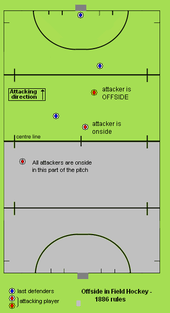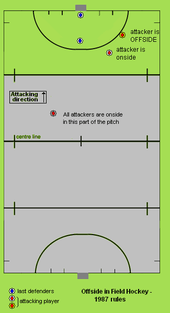Offside (field hockey)
There is currently no offside rule in field hockey. There were prior offside rules, rules that restricted the positioning of players from the attacking team in a way similar to the offside rule in association football. The evolution of the field hockey offside rule culminated with its abolition in the mid-1990s.
History of the offside rule
1876 rule
A set of rules of field hockey was drawn up by several clubs in London in January 1876 following the establishment of the first, briefly existing, Hockey Association (of England) the year before. (The second, and final, Hockey Association was formed in 1886.) An offside rule was included in the 1876 rules. Under this rule, a player who was nearer to the opponent team's goal-line than both the ball and the third to last opponent was said to be at an offside position (simply put: an attacking player was offside if the ball was behind them and there were fewer than three defenders between them and the goal they were attacking). The rule was applied on the whole pitch, except when the ball was hit from the goal-line.
1886 rule
In 1886, the second England Hockey Association drew up a code of Rules based on those used by clubs in the London area. Offside was then applied to attacking players from the half-way line only.
1972 rule change
The 1886 offside rule remained unchanged until 1972, when offside was changed from 3 to 2 defenders.
1987 rule change
In 1987, the offside was amended to apply only in the 25 yards area.
Offside abolished
After various amendments, the offside rule was finally repealed. "No offside" was introduced as a mandatory experiment in 1990 and it was confirmed as a rule in 1992 by the Hockey Rules Board. The aims of this change were:
- to transfer the balance of power towards the offense,
- to create more space around the circle and mid-field,
- to help the flow of play, more goals and fewer whistles, and
- to make the game more exciting and appealing to spectators.
New tactics were developed by many teams to exploit this new rule.
Evolution of the offside rule in diagrams
 1876 rule |
 1886 rule |
 1972 rule |
 1987 rule |